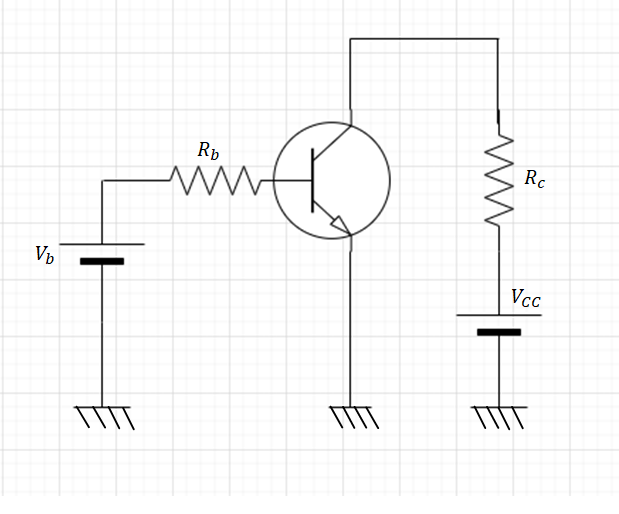
A common emitter amplifier circuit built using an n-p-n transistor is shown in the figure. Its DC current gain is 250

a.
b.
c.
d.

Answer
465k+ views
Hint: The n-p-n transistor is the transistor which is used to when we need to sink the current .Current gain is ratio between collector current and base current so first calculate collector current then use current gain equation to calculate the base current.
Formula used:
The formula for the collector current is given by,
Where the collector current is
Complete step by step answer:
Step1:
At the saturation point the voltage
Given that
Therefore current in the collector is given by-
The value of
Step2:
Now use the current gain equation to calculate the base current.
Where
Put values in above equation we get,
The required current in the base is equal to
Hence, the correct answer is option (C).
Additional information:
The configuration in which the emitter is connected between the collector and base is known as a common emitter configuration. The input circuit is connected between emitter and base, and the output circuit is taken from the collector and emitter. Thus, the emitter is common to both the input and the output circuit, and hence the name is the common emitter configuration.
Note: The saturation region allows the transistor to conduct current from the emitter to the collector. With both the base collector junction and the base emitter junction forward-biased, the base current is so strong it exceeds the magnitude at which it can increase the collector current flow. Always keep in mind that at the saturation point
Formula used:
The formula for the collector current is given by,
Where the collector current is
Complete step by step answer:
Step1:
At the saturation point the voltage
Given that
Therefore current in the collector is given by-
The value of
Step2:
Now use the current gain equation to calculate the base current.
Where
Put values in above equation we get,
The required current in the base is equal to
Hence, the correct answer is option (C).
Additional information:
The configuration in which the emitter is connected between the collector and base is known as a common emitter configuration. The input circuit is connected between emitter and base, and the output circuit is taken from the collector and emitter. Thus, the emitter is common to both the input and the output circuit, and hence the name is the common emitter configuration.
Note: The saturation region allows the transistor to conduct current from the emitter to the collector. With both the base collector junction and the base emitter junction forward-biased, the base current is so strong it exceeds the magnitude at which it can increase the collector current flow. Always keep in mind that at the saturation point
Recently Updated Pages
Master Class 9 General Knowledge: Engaging Questions & Answers for Success

Master Class 9 English: Engaging Questions & Answers for Success

Master Class 9 Science: Engaging Questions & Answers for Success

Master Class 9 Social Science: Engaging Questions & Answers for Success

Master Class 9 Maths: Engaging Questions & Answers for Success

Class 9 Question and Answer - Your Ultimate Solutions Guide

Trending doubts
Give 10 examples of unisexual and bisexual flowers

Draw a labelled sketch of the human eye class 12 physics CBSE

Differentiate between homogeneous and heterogeneous class 12 chemistry CBSE

Differentiate between insitu conservation and exsitu class 12 biology CBSE

What are the major means of transport Explain each class 12 social science CBSE

a Tabulate the differences in the characteristics of class 12 chemistry CBSE




